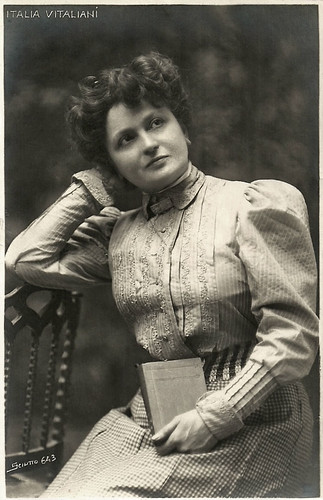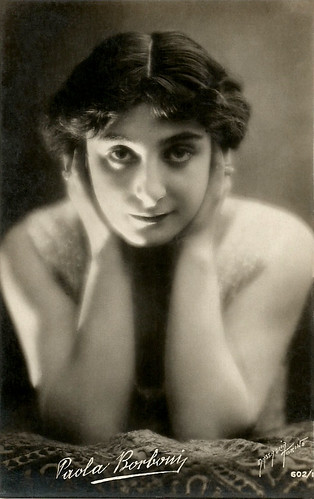Giuseppe Sterni (1883 - 1952) was an Italian stage and sceen actor. In the late 1910's and early 1920's he directed and produced several Italian silent films in which he played the male lead himself. In the 1930's and 1940's, he ran an Italian American theatre company in New York.
![Giuseppe Sterni]()
British postcard, no. 97.
Wandering Artists
Giuseppe Sterni was born in Bologna, Italy in 1883. In 1904 he started his stage career in a company of wandering artists. In 1906-1907 he became 'primo attore giovane' (first young actor) in some stage companies, including that of Italia Vitaliani. In 1908 he was member of the company of the Teatro Adriano in Rome under direction of Alfredo Campioni. He then moved to the companies of Gemma Farina, Mimì Aguglia and Ferruccio Benini. In 1912 he became 'primo attore'(first actor) in the company of the Teatro Manzoni of Milan, directed by Febo Mari. In 1913 he became director himself of the theatrical companies of first Mimì Aguglia and then that of Olga Vittoria Gentili. In 1916 Sterni temporarily left the stage for the cinema. He worked at several production companies, in particular at Milano Films, both as actor and director. He made his film debut in Bene contro male/Good against evil (1916, Gigi Armandis). Then followed Così è la vita/Such is life (1917) and I Mohicani di Parigi/The Mohicans of Paris (1917, Eugenio Perego), both with Lina Millefleurs. Simultaneously, Sterni started to direct films as well and often played the lead in these films. He directed La madre/The mother (1916) with Italia Vitaliani as the title figure. Sterni played her son, an ambitious young painter who discovers his mother is his best model. In the same year he also starred in and directed Amanda (1916) with Lina Millefleurs. He worked again with Millefleurs in Tristi amore/Sad Love (1917). Other actresses he worked with were Suzanne d’Armelle in L’antica fiamma/The old flame (1917), Linda Pini in La storia di una capinera/The story of a sparrow (1917) and Paola Borboni in Jacopo Ortis (1918).
![Giuseppe Sterni]()
Italian postcard by Vettori, Bologna, no. 2000.
Italian American
Giuseppe Sterni returned in 1918 to the stage joining the company of Emma Gramatica. After a year he became director of the company of the Teatro Eclettico. In 1921 he began again to direct and act in films. Sterni worked with such well known actresses as Paola Borboni in Sinfonia pastorale/Pastoral symphony (1921), and L’ora della morte/Time of death (1921), and with Carmen Boni in Passione di popolo/Passion for people (1921). After five films at Olimpus Film in 1921, he founded his own film production company in Rome, Sterni Film. He produced I disonesti/The dishonest (1922) with Linda Pini, and L'incubo (1922), but Sterni Film was short-lived. During the 1920's Sterni did a tour to New York, where he remained. In 1929 he founded the Teatro d'Arte Italiano, a small stage company with a repertory ranging from William Shakespeare to Giovanni Verga, Gabriele D'Annunzio and Luigi Pirandello. Sterni became very popular within the Italian American community in New York and he also traded in antiques there. He would stay in New York until his rerirement in 1949. Giuseppe Sterni died in Rome in 1952. He was 68.
![Italia Vitaliani]()
Italia Vitaliani. Italian postcard by NPG, no. 643. Photo: Sciutto.
![Linda Pini]()
Linda Pini Italian postcard.
![Paola Borboni]()
Paola Borboni. Italian postcard, no. 602/1. Photo: Massaglia, Torino.
Sources: Wikipedia (Italian) and IMDb.

British postcard, no. 97.
Wandering Artists
Giuseppe Sterni was born in Bologna, Italy in 1883. In 1904 he started his stage career in a company of wandering artists. In 1906-1907 he became 'primo attore giovane' (first young actor) in some stage companies, including that of Italia Vitaliani. In 1908 he was member of the company of the Teatro Adriano in Rome under direction of Alfredo Campioni. He then moved to the companies of Gemma Farina, Mimì Aguglia and Ferruccio Benini. In 1912 he became 'primo attore'(first actor) in the company of the Teatro Manzoni of Milan, directed by Febo Mari. In 1913 he became director himself of the theatrical companies of first Mimì Aguglia and then that of Olga Vittoria Gentili. In 1916 Sterni temporarily left the stage for the cinema. He worked at several production companies, in particular at Milano Films, both as actor and director. He made his film debut in Bene contro male/Good against evil (1916, Gigi Armandis). Then followed Così è la vita/Such is life (1917) and I Mohicani di Parigi/The Mohicans of Paris (1917, Eugenio Perego), both with Lina Millefleurs. Simultaneously, Sterni started to direct films as well and often played the lead in these films. He directed La madre/The mother (1916) with Italia Vitaliani as the title figure. Sterni played her son, an ambitious young painter who discovers his mother is his best model. In the same year he also starred in and directed Amanda (1916) with Lina Millefleurs. He worked again with Millefleurs in Tristi amore/Sad Love (1917). Other actresses he worked with were Suzanne d’Armelle in L’antica fiamma/The old flame (1917), Linda Pini in La storia di una capinera/The story of a sparrow (1917) and Paola Borboni in Jacopo Ortis (1918).

Italian postcard by Vettori, Bologna, no. 2000.
Italian American
Giuseppe Sterni returned in 1918 to the stage joining the company of Emma Gramatica. After a year he became director of the company of the Teatro Eclettico. In 1921 he began again to direct and act in films. Sterni worked with such well known actresses as Paola Borboni in Sinfonia pastorale/Pastoral symphony (1921), and L’ora della morte/Time of death (1921), and with Carmen Boni in Passione di popolo/Passion for people (1921). After five films at Olimpus Film in 1921, he founded his own film production company in Rome, Sterni Film. He produced I disonesti/The dishonest (1922) with Linda Pini, and L'incubo (1922), but Sterni Film was short-lived. During the 1920's Sterni did a tour to New York, where he remained. In 1929 he founded the Teatro d'Arte Italiano, a small stage company with a repertory ranging from William Shakespeare to Giovanni Verga, Gabriele D'Annunzio and Luigi Pirandello. Sterni became very popular within the Italian American community in New York and he also traded in antiques there. He would stay in New York until his rerirement in 1949. Giuseppe Sterni died in Rome in 1952. He was 68.

Italia Vitaliani. Italian postcard by NPG, no. 643. Photo: Sciutto.

Linda Pini Italian postcard.

Paola Borboni. Italian postcard, no. 602/1. Photo: Massaglia, Torino.
Sources: Wikipedia (Italian) and IMDb.